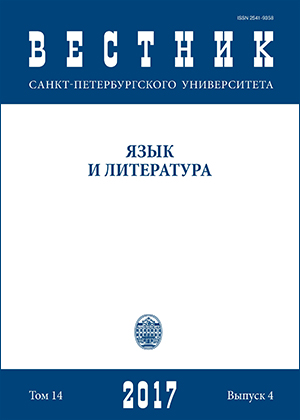Epideictic Function of the Historical Narrative in J. Higgins’ Versified Monologues («The Mirror for Magistrates») and in E. Spenser’s «Briton Moniments» («The Faerie Queene», Book II, Canto X)
DOI:
https://doi.org/10.21638/11701/spbu09.2017.404Abstract
The article compares a part of Edmund Spenser’s “The Faerie Queene” and the monologues added to “The Mirror for Magistrates” by J. Higgins. No one has published in Russian a comparison of these two works. This article establishes Elizabethan notions of the functions of historical writing as a theoretical context of the study. Since moralizing and praising were regarded as the main functions of history and historical poetry, the realisation of epideictic and didactic functions in the texts concerned became the subject of our analysis. Spenser and Higgins were contemporaries, they both were concerned with the same historical period, and they shared the same text as their main source — all these established the grounds for our comparison. The earliest period of the British history and episodes where female characters were among the main actors, — the stories ofLocrine and Guendolene, Leire and Cordeile, — appeared to be the most important for both authors. The analysis showed that didactic and epideictic functions were realized in both texts, although not in the same degree. Moralising dominated in Higgins’ monologues, while praising dominated in Spenser’s text. Higgins believed the reign of Britain’s first king Brutus was a prosperous golden age, followed however by a train of misfortunes by the depiction of which he teaches us the uncertainty of political life. Spenser also praised Brutus’ Britain, calling it an “empire”, but even more clearly epideictic function was realized in his account of the episodes with Guendolen and Cordeila. Having more independence than they were allowed in these texts, they were said by Spenser to be good rulers. Moreover, Spenser slightly transformed the story to present Guendolen more favourably. The poet there skillfully used a tale about Elizabeth I’s ancestors to praise the Queene.
Keywords:
Faerie Queene, E. Spenser, Renaissance historical poetry, Mirror for Magistrates, Locrin, Leir, epideictic function, didactic function
Downloads
References
Библиография:
Алексеев 1984 — Алексеев М. П. Литература средневековой Англии и Шотландии. М.: Высшая школа, 1984. 351 с.
Бурова 2015 — Бурова И. И. “Легенда о Локрине и ее интерпретация в английской литературе Елизаветинского периода”. Филология и культура. 40 (2), 2015: 181–185.
Burkhardt 1975 — Burkhardt R. E. “History, the Epic and the ‘Faerie Queene’ ”. English Studies. 56 (1), 1975: 14–19. (англ.)
Farnham 1926 — Farnham W. “John Higgins’ “Mirror” and “Locrine”. ” Modern Philology. 23 (3), 1926: 307–313. (англ.)
Harper 1910 — Harper C. A. The Sources of the British Chronicle History in Spenser’s “Faerie Queene”. Philadelphia: John C. Winston, 1910. 210 p. — (Modern Philology) (англ.)
Quitslund 2000 — Quitslund B. “Elizabethan Epideixis and the Spenserian Art of State Idolatry”. The European Legacy. 5 (1), 2000: 29–48. (англ.)
References
Алексеев 1984 — Alekseev M. P. Literatura srednevekovoi Anglii i Shotlandii [Literature of England and Scotland in the Middle Ages]. Moscow: Vysshaia shkola, 1984. 351 p. (Russian)
Бурова 2015 — Burova I. I. “Legenda o Lokrine i ee interpretatsiia v angliiskoi literature Elizavetinskogo perioda [Legend about Locrine and its interpretation in the English literature of the Elizabeth’s era].” Filologiia i kul’tura — Philology and Culture. 40 (2), 2015: 181–185. (Russian)
Burkhardt 1975 — Burkhardt R. E. “History, the Epic and the “Faerie Queene”. ” English Studies. 56 (1), 1975: 14–19. (English)
Farnham 1926 — Farnham W. “John Higgins’ “Mirror” and “Locrine”. ” Modern Philology. 23 (3), 1926: 307–313. (English)
Harper 1910 — Harper C. A. The Sources of The British Chronicle History in Spenser’s “Faerie Queene”. Philadelphia: John C. Winston Publ., 1910. 210 p. — (Modern Philology) (English)
Quitslund 2000 — Quitslund B. “Elizabethan Epideixis and the Spenserian Art of State Idolatry”. The European Legacy. 5 (1), 2000: 29–48. (English)
Downloads
Published
How to Cite
Issue
Section
License
Articles of "Vestnik of Saint Petersburg University. Language and Literature" are open access distributed under the terms of the License Agreement with Saint Petersburg State University, which permits to the authors unrestricted distribution and self-archiving free of charge.






